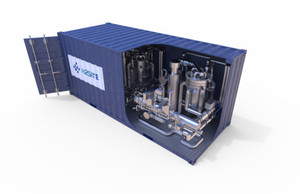Revolutionizing Hydrogen Production: Ammonia Cracker with Membrane Reactor Technology
Key Ideas
- H2SITE receives EIC Accelerator program for a groundbreaking ammonia cracking unit, producing 1 ton of high-purity hydrogen daily.
- The membrane reactor technology by H2SITE offers cost-efficiency, energy savings, high-purity hydrogen output, and a compact design.
- The project aims to validate the commercial readiness of the technology for decentralized hydrogen production and advance decarbonization in hard-to-abate sectors.
- Advances in ammonia cracking, like H2SITE's approach, will play a key role in enabling competitive and scalable low-carbon hydrogen supply chains.
H2SITE has been granted the EIC Accelerator program to develop an innovative ammonia cracking unit in Bilbao, Spain, capable of producing 1 ton of high-purity hydrogen daily. The unit is based on H2SITE's unique palladium-based membrane reactor technology, allowing simultaneous ammonia decomposition and hydrogen separation. This technology offers cost-effectiveness, energy efficiency, high hydrogen purity suitable for fuel cells, and a compact modular design. The project aims to showcase the commercial viability of this approach for decentralized hydrogen production, crucial for decarbonizing challenging sectors. H2SITE's CEO, Andres Galnares, sees this as a significant step towards commercializing the technology for various industrial sectors and maritime applications, contributing to the growing hydrogen economy. Ammonia is recognized as a promising hydrogen carrier due to its energy density and existing infrastructure, with over 20 million tons transported annually. Innovations like H2SITE's membrane reactor are vital in making ammonia-based hydrogen pathways competitive, enabling the establishment of large-scale, flexible hydrogen supply chains.
